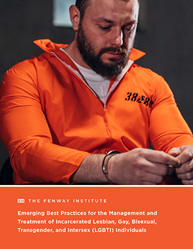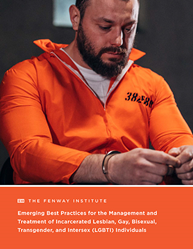
The discrimination that LGBTI people experience in broader society is often mirrored and intensified in the correctional environment. It’s critical [to adopt policies] that increase the safety of individuals in their care, especially those most vulnerable to sexual and violence victimization…
BOSTON (PRWEB)
November 20, 2019
The Fenway Institute released a new report on emerging best practices in the management of LGBTI people in correctional settings at the Massachusetts State House on Wednesday, November 20.
Report co-author Timothy Wang, Senior Policy Analyst at The Fenway Institute, moderated a panel discussion about key recommendations in the report, which is titled “Emerging Best Practices for the Management and Treatment of Incarcerated Lesbian, Gay, Bisexual, Transgender, and Intersex (LGBTI) Individuals.”
Panelists included Sean Cahill, Ph.D., Director of Health Policy Research at The Fenway Institute and a coauthor of the report; Brad Brockmann, an Assistant Professor of the Practice in Health Services, Policy and Practice at Brown University’s School of Public Health and a coauthor of the report; Angelina Resto, a public speaker and advocate for LGBTI people who are incarcerated; and Michael Cox, Director of Policy for Black and Pink, Boston, an advocacy group for LGBTI people affected by incarceration.
The report documents that sexual and gender minority individuals who are incarcerated experience exceptionally high rates of sexual victimization in U.S. prisons and jails as compared to other inmates. It also notes that LGBTI people are disproportionately represented in corrections, most likely due to high rates of harassment and rejection that LGBTQI youth face from their families, schools, and communities, which contributes to the early involvement of LGBTI people in the juvenile justice system. The report also notes that historically same-sex behavior and gender variance were criminalized in the U.S. until recently.
“The discrimination that LGBTI people experience in broader society is often mirrored and intensified in the correctional environment. It’s critical for correctional institutions to adopt policies and practices that increase the safety of individuals in their care, especially those most vulnerable to sexual and violence victimization while imprisoned,” said Cahill. “The need to adopt practices that prevent discrimination and treat all inmate populations fairly doesn’t require correctional officers to change their personal or religious beliefs. All public safety and law enforcement professionals should understand that providing equitable protection to all while on duty is about being an effective professional.”
Key findings from the report are relevant to two pieces of legislation currently before Massachusetts lawmakers:
- Bill S.905, “An Act to collect data on LGBTQI prisoners held in restrictive housing,” would require facilities in Massachusetts to regularly collect data and report on the status of LGBTQI prisoners held in restrictive housing. As noted in the report, LGBTI people may be subjected to solitary confinement more frequently than their heterosexual and cisgender peers, and decades of research have shown that solitary confinement can lead to significant, long-term harm to physical and mental well-being. Of particular concern, anecdotal evidence from formerly incarcerated LGBTI people indicate that the Prison Rape Elimination Act (PREA) is being misinterpreted and misused by staff to disproportionately punish LGBTI inmates with solitary confinement. The first step in ending the misuse of PREA and bringing oversight to the use of solitary confinement against LGBTI inmates is to pass bill S.905.
- A second bill related to solitary confinement, SD.2532, “An Act to provide criminal justice reform protections to all prisoners in segregated confinement,” would strengthen and enforce protections for inmates placed into solitary or segregated confinement, including LGBTI inmates. The bill was created in response to the Department of Correction’s creation of new units that are technically not “restrictive confinement” within the meaning of current law as amended by the Criminal Justice Reform Action of 2018. In these new units, prisoners are not entitled to periodic placement reviews and conditions-based protections that are afforded to prisoners that meet the technical requirements of “restrictive confinement.” This bill creates an umbrella term of “segregated confinement” to ensure that all prisoners who are not in the general population are afforded the Criminal Justice Reform Act protections. Segregated confinement is defined as a housing placement where a prisoner is separated from the general prison population, and it includes restrictive housing, disciplinary restrictive housing, secure adjustment units, secure treatment units, and mental health watch. Among other changes, the bill makes placement reviews more rigorous and establishes an appeals process to the Superior Court for longer-term segregated confinement.
Best practices and key recommendations identified in the report include:
- Continuing to follow the recommendations for housing outlined in Prison Rape Elimination Act (PREA) standards, which states that housing decisions for transgender and intersex inmates should be made on a case-by-case basis that “seriously consider[s]” the inmates’ own wishes regarding where they feel the safest. Although the federal Bureau of Prisons under the Trump Administration is now housing transgender people based on their “biological sex” or sex at birth, state and local prison and jail systems can continue to follow the best practice of placing transgender women in women’s prisons. As of December 2018, according to Massachusetts state law, transgender prisoners should be “housed in a correctional facility with inmates of the same gender identity,” as long as this is consistent with the prisoner’s request and the prisoner’s health and safety.
- PREA standards require corrections professionals to collect sexual orientation and gender identity information at intake and use it on a need to know basis to protect LGBTI inmates against sexual assault and physical violence. Federal and state prison data show that LGBT people, both adults and juveniles, are up to 10 times as likely to be raped in prison. PREA standards are aimed at reducing this victimization. However, PREA should not be used to punish gay and transgender prisoners for hugging, having conversations, or sharing meals together. Each of these activities have resulted in punishment under PREA according to LGBTI people who were formerly incarcerated in Massachusetts, and who will speak at the Nov. 20 event.
- Solitary confinement should not be used to “protect” LGBT and intersex inmates. Solitary constitutes cruel and unusual punishment and should not be used in this way.
- PREA seeks to end rape in prison. While the concept of consent in prison is fraught and complex, PREA distinguishes between coercive and consensual sex. PREA does not prohibit consensual sexual activity and does not allow for punishment invoking PREA for such activity. The PREA standards state that same-sex activity should not be considered sexual abuse if the facility staff determine that the conduct was not coerced.
- LGBTI people have unique health risks and concerns that health care providers in correctional facilities should be equipped to address and treat in a competent and nondiscriminatory manner. Prisoners are more likely than the general population to be living with HIV and/or Hepatitis C. Facilities must ensure that LGBTI inmates have access to medical personnel who are knowledgeable about the health needs of LGBTI individuals.
- Sometimes intersex and transgender prisoners are subjected to voyeuristic strip searches by corrections staff. This is abuse and it is explicitly prohibited in the PREA standards. Gender nonconforming prisoners have the right to specify whether they want a male or female corrections officer to search them.
The practices set forth in the report, titled “Emerging Best Practices for the Management and Treatment of Incarcerated Lesbian, Gay, Bisexual, Transgender, and Intersex (LGBTI) Individuals” are based on policies already implemented in various correctional systems, including in Texas, Colorado, Pennsylvania and California. These policies are emerging as best practices based on professional consensus. They cover intake, classification and housing placement, medical care, same-sex behavior and condom availability, privacy and confidentiality, and group inmate management for incarcerated LGBTI individuals.
Facts related to the incarceration of LGBTI people:
- Just 4.5% of U.S. adults identify as LGBT, according to the Gallup Poll, yet 9.3% of men in prison, 6.2% of men in jail, 42.1% of women in prison, and 35.7% of women in jail identify as sexual minorities, according to the National Inmate Survey.
- The 2015 National Transgender Discrimination Survey found that 16% of survey respondents had been in jail or prison at least once. Two percent said that they were incarcerated in the past year, more than twice the rate of the general population. Nine percent of Black transgender women said that they were incarcerated in the past year.
- Of the transgender respondents who were incarcerated within the past year, 23% reported being physically assaulted by corrections staff or another inmate, and 20% reported being sexually assaulted by a staff member or inmate.
- Gay or homosexual men are 11 times as likely as heterosexual men to report being sexually victimized by another inmate, and bisexual males are 10 times as likely.
- Bisexual women prisoners are more likely to report sexual assault by another prisoner than heterosexual or lesbian prisoners, and incarcerated bisexual and lesbian women report higher rates of sexual assault by prison staff than do heterosexual women.
- Intersex and transgender prisoners can experience trauma as a result of voyeuristic strip searches conducted by staff, forcing female-identified inmates to shower with men, and sexual harassment by staff and other inmates.
Share article on social media or email:

